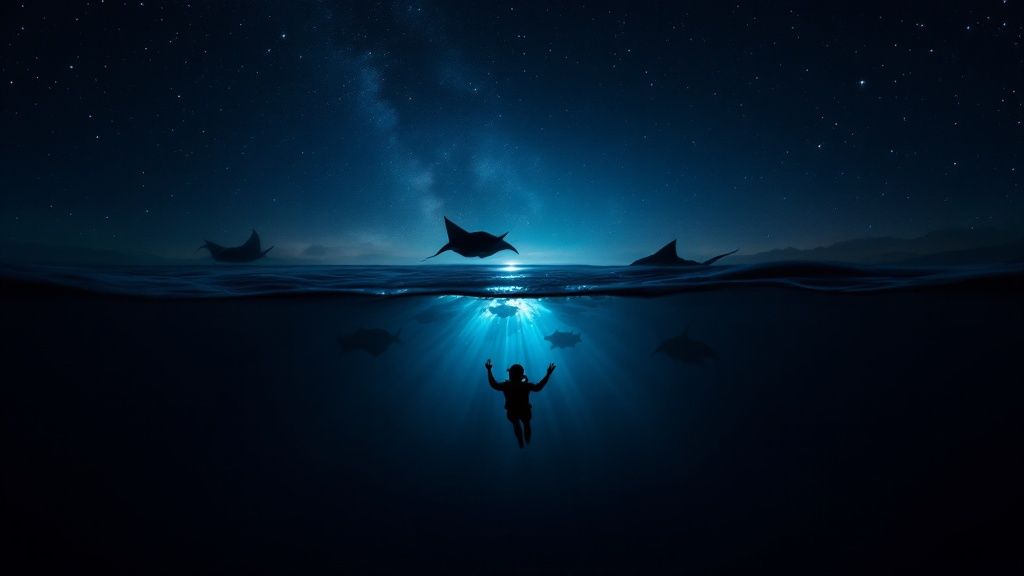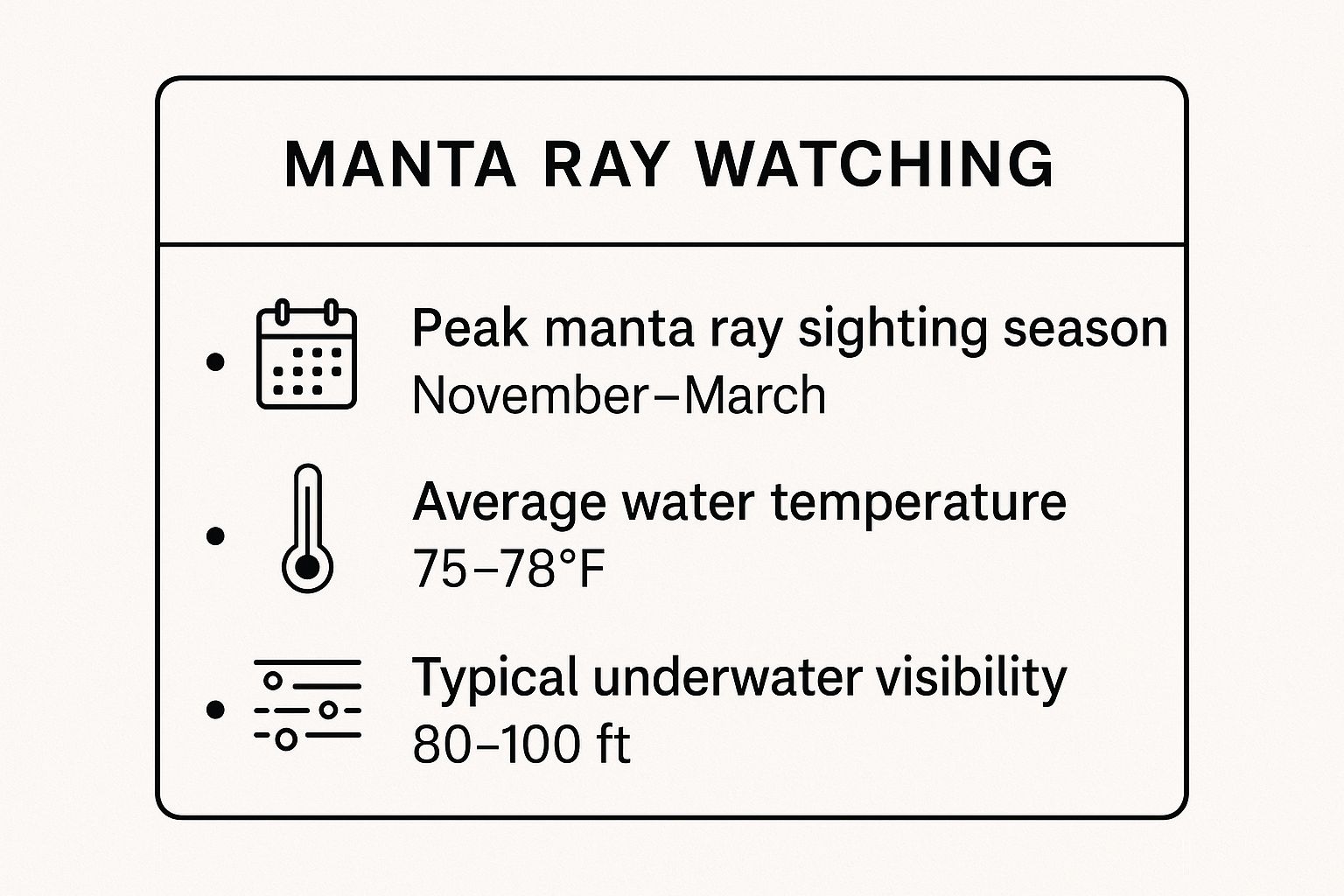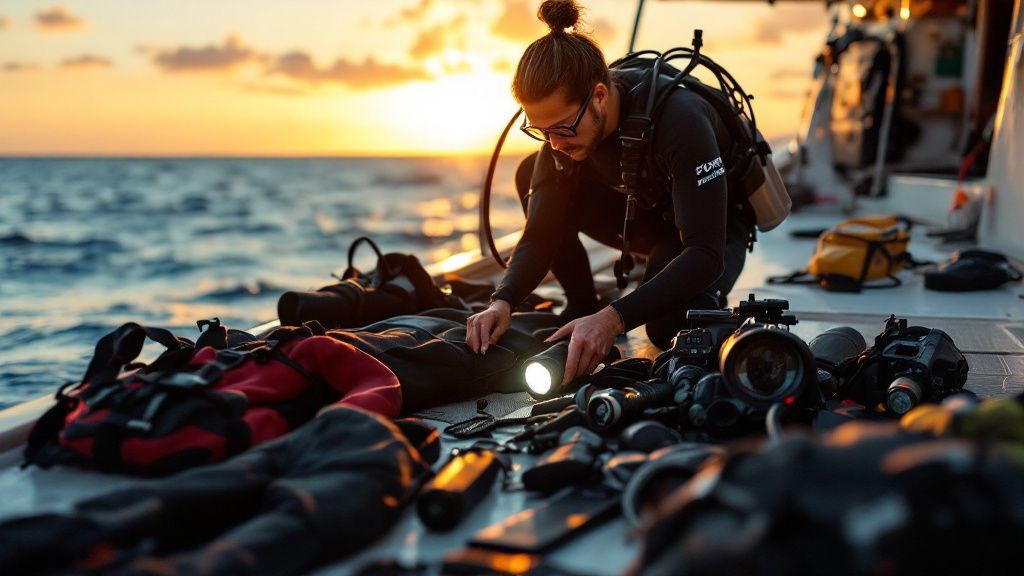Why Manta Dive Kona Transforms Every Diver's Perspective
Manta rays possess an undeniable allure, captivating divers and snorkelers with their graceful movements and impressive size. However, a manta dive in Kona offers something truly exceptional – an experience that transcends a typical wildlife encounter and etches itself into the memory of every diver. This unique experience arises from a convergence of geographical features, ideal marine conditions, and responsible conservation practices.
The Kona Coast: A Manta Ray Haven
Kona's volcanic underwater topography plays a key role in creating this manta ray haven. Deep slopes and canyons channel nutrient-rich currents, fostering the growth of plankton, the manta ray's primary food source. This creates a reliable "buffet," attracting these gentle giants night after night. This consistency is what sets Kona apart.
While other locations might offer fleeting glimpses of manta rays, Kona boasts remarkably high sighting rates. In fact, the Kona Coast in Hawaii is renowned for its manta ray sighting success, with an average of 85-90% of dives resulting in manta ray encounters. This reliability is attributed to the unique underwater environments of sites like Manta Village and Manta Heaven. Find more detailed statistics here. These locations provide ideal conditions for manta rays, as they are attracted to the bioluminescence of plankton.

The "Manta Ballet": An Underwater Spectacle
The underwater topography further enhances the viewing experience. The sloping volcanic seabed is perfectly suited for the "campfire" technique employed by dive operators. Divers gather around specialized lights that attract plankton, drawing the mantas closer.
This results in an awe-inspiring display of graceful barrel rolls and chain-feeding formations just below the surface. Imagine observing these majestic creatures, with wingspans reaching up to 16 feet, gliding effortlessly just inches above you. This intimate interaction is unlike any other wildlife encounter and profoundly impacts even the most seasoned divers. If you're interested in building websites, WordPress is a popular platform.
More Than Just a Dive: A Conservation-Focused Experience
The manta dive in Kona is more than just a dive; it's a carefully orchestrated interaction between humans and these magnificent creatures. Dive operators prioritize ethical practices, ensuring minimal disruption to the manta rays' natural behavior.
They emphasize passive observation and educate divers on the importance of respecting these gentle giants. This focus on conservation ensures that these encounters remain possible for generations to come. The experience often leaves divers with a renewed appreciation for marine life and a deeper understanding of the interconnectedness of our ocean ecosystems.
This emotional connection forged during these encounters is what truly transforms a diver's perspective, leaving them with a sense of wonder and a desire to protect these incredible animals.
Mastering Kona's Premier Manta Ray Dive Sites
To truly experience the magic of Kona's manta rays, understanding the nuances of each dive site is essential. For those also interested in snorkeling, check out this helpful resource on snorkeling with manta rays in Kona. The Kona coast offers a variety of locations, each with its own distinct charm and appeal. Picking the right spot can significantly enhance your dive, ensuring it aligns with your experience level and desired interaction with these gentle giants.
Manta Village: The Heart of the Action
Manta Village, nestled in Keauhou Bay south of Kona, is famous for its shallow depth, averaging 30-40 feet. This makes it perfect for divers of all skill levels, from beginners taking their first plunge to seasoned pros. The sandy bottom and typically calm waters provide excellent visibility, offering a crystal-clear view of the mesmerizing "manta ballet." Divers form a semi-circle on the seabed, shining their dive lights upwards. This attracts plankton, the mantas' primary food source, drawing them close to the surface for an unforgettable feeding display. This predictable behavior ensures consistent and close-up encounters.
Manta Heaven: A Deeper Dance
For a slightly different experience, Manta Heaven, located north of Kona off the airport, beckons with the promise of larger manta ray gatherings. The waters here are a bit deeper and sometimes experience stronger currents, making it more suitable for experienced divers. While sightings might be slightly less frequent compared to Manta Village, the chance to witness multiple mantas gracefully gliding and feeding together is a truly breathtaking spectacle. Manta Heaven offers a unique and immersive experience for those seeking a deeper connection with these magnificent creatures.
Beyond the Well-Known: Hidden Gems
Beyond the popular Manta Village and Manta Heaven, Kona boasts a few lesser-known manta dive sites, often favored by local divers. These hidden gems offer a more secluded and intimate experience, away from the crowds. While manta ray sightings might be less predictable, the reward is the potential for a truly private encounter with these gentle giants. These quieter locations often feature unique underwater topography and diverse marine life, adding another layer of richness to the dive.
To help you choose the best dive site for your next manta ray adventure, take a look at the comparison table below:
Kona Manta Ray Dive Site Comparison
This table compares the main manta ray dive sites in Kona, highlighting key characteristics to help divers choose the best location for their experience level and preferences.
| Dive Site | Average Depth | Best Time | Experience Level | Special Features | Accessibility |
|---|---|---|---|---|---|
| Manta Village | 30-40 feet | Night | Beginner to Advanced | Predictable sightings, shallow depth | Easy access from shore |
| Manta Heaven | 40-50 feet | Night | Intermediate to Advanced | Potential for larger groups, deeper dive | Boat access required |
| Hidden Gems (various) | Varies | Varies | Varies | Secluded experience, unique landscapes | Varies, often boat access |
As you can see, each site offers a unique experience. Consider your comfort level and what you hope to see when making your selection.

The infographic above provides a visual overview of key planning information for your Kona manta ray dive, including peak season, average water temperature, and typical visibility. The best time to dive is during the winter months (November–March), when the water temperature is a pleasant 75–78°F and visibility reaches an impressive 80–100 feet. With optimal conditions and careful site selection, your Kona manta ray dive is sure to be an unforgettable experience.
What Happens During Your Manta Dive Kona Adventure
Embarking on a manta dive in Kona is a truly unique experience, a graceful dance between humans and these incredible creatures. From the initial briefing to the post-dive excitement, every moment creates a memory you won't soon forget. Let's explore what awaits you on a Kona manta dive adventure.
Preparing for the Encounter: The Pre-Dive Briefing
Your adventure begins with a thorough pre-dive briefing. Expert guides, like those at Kona Honu Divers, carefully explain the dive procedures, outlining manta ray behavior and stressing the importance of respectful observation. This briefing isn't just about safety; it's about fostering a responsible and sustainable interaction with these gentle giants. You can learn more about this amazing activity here: What is a manta ray night dive?. The guides also take this opportunity to share knowledge about Kona's distinct ecosystem and explain why this particular area attracts so many manta rays.
The "Campfire" Technique: Illuminating the Night
Once at the dive site, divers enter the water and descend to the seabed, usually a sandy bottom in relatively shallow water. Here, they congregate around special lighting systems, a method called the "campfire" technique. These lights aren't simply for visibility; they attract plankton, the manta rays' primary food source. As the plankton gathers in the illuminated zone, so do the mantas, creating a breathtaking display just below the surface.
The Manta Ballet: A Symphony of Grace
The true magic unfolds as the manta rays appear, drawn in by the glowing plankton. They move gracefully through the water, their enormous wingspans performing a captivating underwater ballet. Their movements are mesmerizing, a symphony of elegant barrel rolls and intricate chain-feeding patterns. This up-close encounter offers a remarkable chance to observe their unique markings and witness their natural behaviors.
Post-Dive Reflections: A Changed Perspective
As the dive ends and you return to the boat, the experience stays with you. The sheer size and grace of these 16-foot creatures, swimming so close, leave a lasting impact. The knowledge that the Kona manta ray population is estimated at over 450 individuals deepens the appreciation for this vibrant ecosystem. This, combined with an average dive time of 45-60 minutes and sighting success rates exceeding 95%, solidifies Kona's position as a top manta ray destination. Explore this topic further. The entire experience often instills a newfound respect for marine life and a greater understanding of conservation.

The Fascinating Science Behind Kona's Manta Population
The magic of a manta dive Kona isn't just about a breathtaking encounter; it's rooted in fascinating science. Decades of research have transformed our understanding of these gentle giants, making Kona's manta ray population one of the most studied in the world. This knowledge enriches the dive experience, informing conservation and fostering deeper appreciation.

Unique Identifiers: Unlocking Manta Mysteries
One cornerstone of manta ray research is the use of their unique ventral patterns. Like fingerprints, these patterns allow scientists to identify and track individual mantas throughout their lives. This enables researchers to build comprehensive life histories for each manta, offering insights into their movements, social interactions, and population dynamics. Imagine tracking a single manta's journey for decades! This individual-level tracking is crucial for long-term monitoring and conservation.
Citizen Science: Tourists as Research Partners
A remarkable aspect of Kona's manta ray research is the role of citizen science. Data collected by tourists, including photos and videos, contributes significantly to research. This collaboration between scientists and the public has revolutionized our understanding of manta behavior. For example, tourist observations have helped identify new cleaning stations and track the movements of pregnant females. This partnership shows how responsible tourism can play a role in marine conservation.
Surprising Discoveries: Intelligence and Communication
Scientific investigation continues to uncover surprising facts about manta ray intelligence, social structures, and communication. Researchers are exploring potential communication through fin movements and body posture changes. Studies suggest a higher level of intelligence than previously thought, with mantas demonstrating learning abilities and potentially complex social interactions. This evolving knowledge makes each manta dive even more captivating. You might be interested in: What is the best time of year to see manta rays in Kona?.
Data-Driven Conservation: Ensuring a Future for Mantas
Research has significantly impacted our understanding of manta ray behavior and conservation. One significant statistical achievement is the detailed documentation of sightings from 2009 to 2014. Underwater videographers conducted night dives six to seven nights a week at sites like Manta Village and Manta Heaven.
The following table presents some key statistics gathered during this period, highlighting the importance of data collection in understanding and protecting these animals.
Kona Manta Ray Population Statistics
| Statistic | Value | Significance | Source Year |
|---|---|---|---|
| Top 20 Sightings (2013) | Recorded | Demonstrates consistent identification of frequently seen mantas | 2013 |
| Monthly Statistics Compiled | Consistent | Provides ongoing data for tracking behavior and population trends | 2009-2014 |
| Individual Tracking | Ongoing | Enables long-term monitoring of individual manta life histories | 2009-2014 |
This table showcases the dedication to collecting reliable data on the Kona manta ray population. These efforts resulted in monthly statistics, including individual manta tracking, physiological condition assessments, and movement patterns within their home range. For instance, in 2013, the top 20 manta rays by appearance frequency were identified. This data has been important for understanding manta ray behavior and predicting higher sighting numbers. Find more detailed statistics here. The data informs conservation strategies, helping establish protected areas and implement responsible diving guidelines. This ensures future generations can experience the wonder of a manta dive, preserving these creatures and their ecosystem.
Preparing For Your Perfect Manta Dive Kona Experience
Want to elevate your manta ray dive in Kona from good to extraordinary? Preparation is key. While knowing the basics of your dive gear is important, getting yourself mentally and physically ready for this unique encounter is where the real magic happens. This guide dives into strategies to maximize your experience, ensuring you’re fully present for this potentially life-changing underwater adventure.
Mental Preparation: Managing Expectations and Anxiety
Night diving can be a bit daunting, especially if you’re new to it. Overcoming any anxiety is crucial to fully enjoying the manta rays. Visualize yourself calm and at ease in the dark water. Focusing on slow, deep breaths can help regulate your heart rate and encourage relaxation, putting you in the right frame of mind to appreciate the wonder of the moment.
Preparing your attention is just as vital as preparing your gear. The ocean at night is a sensory-rich environment. To truly savor the subtle beauty of these encounters, practice observing not just the mantas but the entire ecosystem. Notice the bioluminescent plankton, the gentle sway of the currents, and the quiet sounds of the underwater world.
Understanding Seasonal and Lunar Influences
When you choose to dive can significantly impact your experience. Seasonal changes affect both water visibility and manta ray behavior. During winter (November to March), the water is slightly cooler, but plankton concentrations are often higher, leading to more active manta ray feeding. Summer (June to August), however, typically offers calmer seas and better visibility.
Lunar cycles also play a key role in plankton availability. A full moon frequently means increased plankton, which boosts manta ray activity. Checking the lunar calendar before you dive can help optimize your chances of seeing a truly spectacular feeding frenzy.
Pre-Dive Rituals and Physical Conditioning
Experienced guides recommend a few pre-dive rituals. Staying well-hydrated is essential, as dehydration can worsen seasickness and make it harder to regulate your body temperature. Some light stretching can also help prepare your muscles for the dive, keeping you physically comfortable and helping you maintain neutral buoyancy.
While scuba diving doesn't demand peak athleticism, a decent level of fitness lets you fully enjoy the dive without getting tired. Regular swimming or other water activities can improve your comfort and confidence in the water, contributing to a more relaxing and rewarding experience. Check out our guide on Kona Diving Packages.
Photography Tips for Challenging Light Conditions
Capturing the majestic beauty of manta rays in low light requires special photography techniques. Adjusting your camera settings beforehand is vital. A higher ISO, a wider aperture, and a slower shutter speed can help compensate for the darkness. Be careful not to disturb the mantas with excessive flash photography.
Understanding manta ray behavior can also help you anticipate their movements and get those perfect shots. Observe their feeding patterns and position yourself strategically to capture their graceful barrel rolls and chain-feeding displays without interfering with their natural behavior.
By focusing on these mental and physical preparations, you can turn your manta dive Kona experience from simply "good" to truly unforgettable. This mindful approach not only maximizes your enjoyment but also encourages responsible and respectful interactions with these magnificent creatures.
Beyond Mantas: Creating Your Complete Kona Diving Journey
While the mesmerizing manta ray night dives are a must-see for many, Kona has so much more to offer during the day. Planning a multi-day diving itinerary unlocks the full spectrum of Hawaii's incredible marine ecosystem. Imagine vibrant reefs teeming with life, exploring ancient lava tubes, and encountering pelagic wonders in the deep blue. Let's explore how to create a Kona diving trip that goes beyond the mantas.
Exploring Kona's Diverse Reef Systems
Kona's volcanic origins have created a dramatic and varied underwater landscape. This means a diverse range of dive sites, each with its own unique charm and showcasing Hawaii's marine biodiversity. Shallow reefs are bursting with colorful coral formations, providing shelter for unique Hawaiian fish. These vibrant ecosystems are perfect for divers of all experience levels. Many of these sites are accessible from shore, making them perfect for independent exploration.
Lava Tubes and Underwater Caves: A Geological Adventure
Kona's volcanic past has also left behind fascinating lava tubes and underwater caves. These geological formations offer a thrilling adventure, allowing divers to explore the remnants of ancient volcanic flows. Picture gliding through a darkened cavern, illuminated by your dive light, and emerging into a sunlit cove. It's a unique perspective on Kona's geological history, adding another dimension to your diving experience.
Pelagic Encounters: Venturing into the Deep Blue
Beyond the reefs and lava tubes, Kona’s deeper waters attract a variety of pelagic life. Spinner dolphins are known to frequent certain areas, putting on a show for lucky divers. Nutrient-rich currents attract larger species, like sharks and tuna, offering the chance for open-ocean encounters. Diving at different depths allows you to experience the full range of Kona's marine life, from the smallest reef dwellers to the ocean’s apex predators.
Seasonal Variations and Marine Life Encounters
Just as seasons affect manta ray sightings, they also influence the presence of other marine life. Humpback whales migrate to Hawaiian waters during the winter months (December to May), an awe-inspiring sight for divers. Different turtle species can be encountered throughout the year, each with unique behaviors and habitats. Researching the best time to dive based on your desired encounters is essential to maximizing your underwater experience.
Ready for an unforgettable Kona adventure? Kona Honu Divers offers a wide range of dive tours and packages for all skill levels, from beginner certifications to advanced deep-water explorations. Visit Kona Honu Divers to book your Kona diving adventure today!
